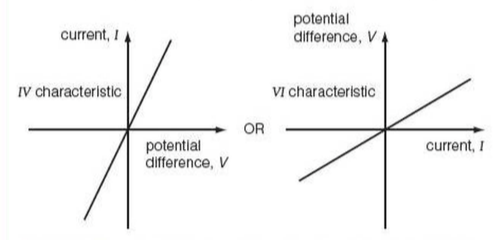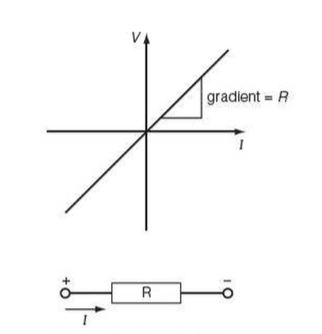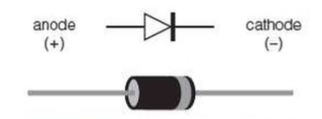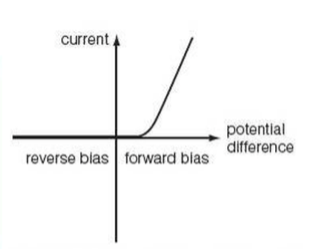Current/Potential Difference characteristics and Ohm's Law
Electrical Characteristic
⇒ Most of the properties of an electrical component can be determined by plotting the current-potential difference graph of the component - this is called an electrical characteristic
⇒ Electrical characteristics are graphs that show how the potential difference and current vary when the component is connected in both forward and reverse bias (when the current passes one way and then in the other direction)
- The most straightforward electrical characteristic is that of a fixed resistor
- You can see that the graph can be drawn with each variable on either axis...

Ohm's Law
⇒ In 1827, the German physicist Georg Ohm performed potential difference-current experiments on metal wires at constant temperatures
⇒ Ohm discovered that the current, I, flowing through the wire was proportional to the potential difference, V, across the wire, provided that the temperature (and other physical variables) remained constant
- If this is shown on an electrical characteristic graph, then the graph will be linear
⇒ The relationship between the current and the potential difference became known as Ohm's law, which can be expressed mathematially by:

- In other words, Ohm's law states that for some conductors current is proportional to potential difference (it is generally a special case applied to metal wires at constant temperature)
⇒ A familiar mathematical equation can be written that uses the relationship between I and V to define the unit of resistance, the Ohm (Ω):

⇒ In other words, if a potential difference of 1V produces a current of 1A flowing through a component, then its resistance must be 1Ω
⇒ This equation applies in all cases and also makes it clear that for a fixed pd, V, a small measured current, I, implies that the component has a large resistance, R, and vice versa
⇒ Similarly, for a fixed current, I, we need a large pd, V, to drive the current through a large resistance, R
Electrical Characteristic Graph
⇒ One use of the electrical characteristic graph is that if the current is plotted on the x-axis, for components following Ohm's law then the gradient of the line is the same value as the resistance of the component
- As fixed resistors and metal wires at constant temperatures have a fixed resistance, then the electrical characteristic graph will be a straight line

⇒ On this type of graph, high-resistance components have large, steep gradients, and low-resistance components have small, shallow gradients
- Remember, though, electrical characteristics can be drawn with either variable on either axis
⇒ Fixed resistors and metal wires at constant temperatures obey Ohm's law across their current range and their electrical characteristics are linear
- Components like this are said to be Ohmic conductors - i.e. they obey Ohm's law
Other electrical characteristics
⇒ A standard tungsten filament lamp tranfers electrical energy into light and heat as the current flows through it
⇒ As the current increases, so the frequency of electron collisions with the positive ion cores of the tungsten lattice increases, transferring more kinetic energy
⇒ The positive ion cores vibrate with greater amplitude so the resistance increases
⇒ A higher current leads to a higher temperature, which in turn leads to a higher resistance
⇒ The electrical characteristic of a filament lamp is shown below:

⇒ The electrical characteristic shows the ratio V/I increasing and therefore the resistance increasing
- Components like this, whose electrical characteristics are non-linear, are said to be non-ohmic conductors
⇒ Components such as fixed resistors and filament lamps have the same characteristics independent of the direction of the current flowing through them
- Their V-I graphs produce the same shapes in forward and reverse bias
⇒ Components such as semiconductor diodes do not behave in this way
- Diodes are generally found in electronic circuits where they act as one-way gates, preventing the current from flowing back through the circuit
- They are particularly useful in mains power supplies where they can be used in circuits to convert alternating current (ac) into direct current (dc)
Diodes
⇒ Diodes only conduct in forward bias (in the direction of the arrow on the symbol); their current symbol shows this direction using the arrow, and the component itself normally has a different coloured ring at the forward bias end

⇒ Diodes do not conduct in reverse bias; this means that the resistance of the diode in reverse bias is infinite
⇒ Diodes have very low resistance in forward bias
⇒ The electrical characteristics of diodes are usually drawn in current (y-axis)-potential difference (x-axis) format:

Extra
⇒ Also see our notes on: